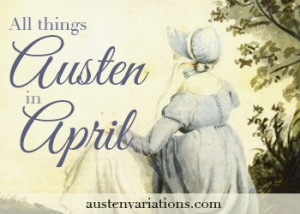 Welcome to All Things Austen in April!
Welcome to All Things Austen in April!
Today I’ll be talking a bit about the area the Gardiners lived in and I have a little peek preview of my WIP.
One of the memorable moments of Pride and Prejudice is the sneering remark Miss Bingley makes to Mr. Darcy about Elizabeth’s uncle’s house in “Cheapside,” with the goal, of course, of making it sound like the Gardiners live in the Cheap side of London. The name of the district has unfortunate associations. Apart from the first meaning, the word cheap is from old English ceapan, ‘to buy’ and refers to a market street. Of course, anything to do with commerce would have been considered unfashionable to the social circles in which Darcy moves. Naturally, as a social climber, Miss Bingley wants to distance herself as much as possible from anything with a whiff of trade. Now this is interesting because, with Jane Austen’s brother being involved in banking, along with the Austen family connection with Warren Hastings, who started off his career as a clerk in the East India Company, we would have to wonder if upper-class society wasn’t, in fact, more complex in its perception of “trade” than Miss Bingley would have us believe.
Certainly the world of fashionable society was not completely cut off from the world of wealthy commerce. Gracechurch Street in particular would have been familiar to Darcy and Georgiana as the warehouses there were often frequented by upper-class society. This image is later than Jane Austen’s time, but it gives you an idea of what it would have looked like on a typical day.
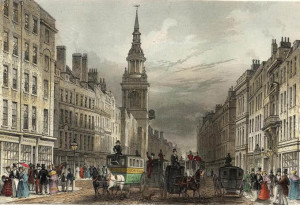
Architecturally, Cheapside was not to be sneered at. Two of London’s largest and most famous churches were located in the area. You can see how Cheapside attracted some very fashionable visitors in this print from 1832. The tall building on the left is Mary-le-Bow, which you’ll probably know of through the nursery rhyme “Oranges and Lemons, said the Bells of old Clemens … said the Great Bells of Bow.”
The Gardiners would only have been able to see the top of the spire of St. Mary-le-Bow from the upper floors of where they lived, but they would have been able to tell the time from the bells, particularly the bell announcing the curfew at 9 o’clock every night. The tradition of the curfew bell at the church was a very long one. It existed as far back 1469 and continued until 1876. It used to mark the end of the workday for apprentices. The bells were destroyed several times, including during the fire of London when the whole church was rebuilt by Christopher Wren. (As an interesting aside, when the old bells deteriorated in the early 20th century, Mr. Selfridge was involved in having them restored). The peal of the bells was the iconic sound of London until Big Ben came into being. This is what they would have heard.
Gracechurch Street itself at the time of Jane Austen continued in a straight line down to the river as Fish Street Hill, where the Monument to the Great Fire of London was located. Just a few steps more and you would be at the Thames, with the old London Bridge extending before you.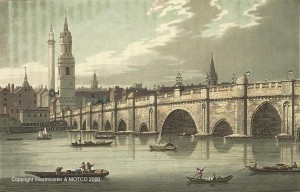
This is the view towards the monument from the river and towards Gracechurch Street.
Immediately to the left of the image would have been the Fishmongers’ Guildhall, one of the powerful twelve Guilds of London, with a building that displayed it’s wealth and status. Definitely, in Jane Austen’s time, the Monument would have been clearly visible from the Gardiner’s 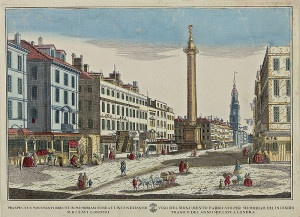 house, as can be seen in this picture looking down Gracechurch Street towards Fish Street Hill, which is where the Monument is located. The monument could be visited for a small charge. The climb to the top involved 315 steps up a spiral staircase.
house, as can be seen in this picture looking down Gracechurch Street towards Fish Street Hill, which is where the Monument is located. The monument could be visited for a small charge. The climb to the top involved 315 steps up a spiral staircase.
In my current WIP, Darcy is rejoicing that Elizabeth has agreed to marry him. He leaves the Gardiner’s house and walks down Gracechurch Street towards the River. It’s rather difficult to trace his route based on a modern map because the landmarks have shifted since then. The old London Bridge was torn down and replaced with a new one in a different position, and streets were shifted accordingly. In Darcy’s case, his walk down towards the river follows a straight line from Gracechurch, through Fish Street Hill down to London Bridge.
Here is an excerpt.
As he passed Monument Yard, Darcy looked up towards the gilded top of the Monument. He had been up there when he was child, had counted all three hundred and eleven steps with his father and stared down from the top at the spiral staircase that looked like the inside of a seashell. The view from the viewing platform – the highest point in London, his father told him — had been both wondrous and frightening. He had gazed out over the city spreading on and on, until his father had tapped his shoulder and told him they should go down. When they were once more outside the towering column, his father had made him read the Latin inscriptions on each side.
The memory saddened him. He would have liked his father to be present for his wedding. He had few memories of his mother. He had been too young when she had died. It was at times like this that he wished they were still with him to celebrate the occasion.
He dismissed the gloomy thoughts. It was up to him now to create a new life for himself. He would take his own children up, as his father had done with him. Meanwhile, he would go up with Elizabeth, he determined. She was a good walker and would be able to climb the spiral staircase easily. They would stand at the top of the world and hold hands and look down over the spires and house-tops of London together. He caught sight of himself grinning in the elegant looking-glass in the window of Wilcoxon and gave a start. Was this handsome man with a joyful expression really him?
The bells of St Mary-le-Bow pealed, the musical resonance of her ancient bells filling the falling dusk. Darcy was tempted to go in to give thanks for the happiness that had been granted to him, but he was in too much turmoil to wish to be enclosed. He was still reeling with a sense of disbelief that his life had been so completely altered in the course of one day. The cloud that had hung over him for weeks – nay, months – had finally dissipated, leaving him with a fierce joy that was almost overwhelming. Yet he could not find peace, not yet, not until he had resolved matters with Mr. Bennet.

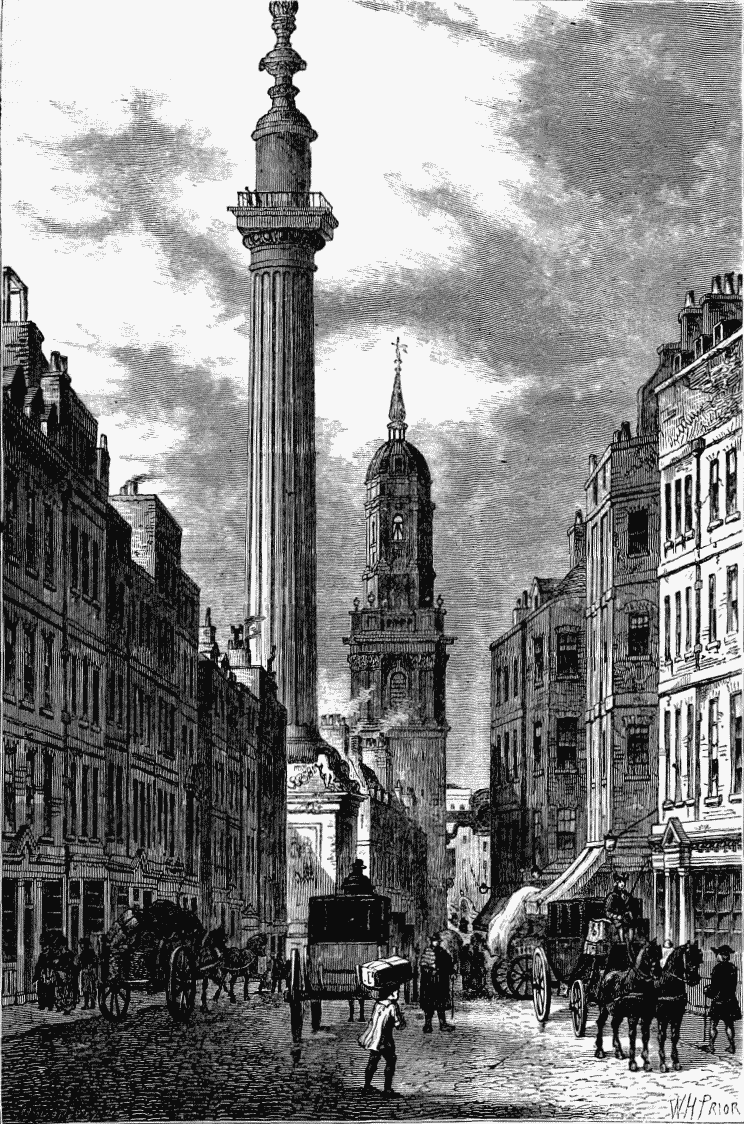
46 comments
Skip to comment form
Wow! I am looking forward to reading this when it’s finished. Thanks for the delightful Darcy fix you gave us, and for the history of that street. It was marvelous, and very interesting to read.
Author
I’m glad you enjoyed it, Mari!
Very interested tidbit of history. Your excerpt was great. Can’t wait for the book!
Author
Very kind of you to say so, Deb.
I love the description of Darcy’s watlk, and his memory of climbing the monument with his father. Thank you for a peek at a country I’ve never seen.
Author
It’s a country none of us now can really know, June. Gracechurch Street now is just a jumble of modern buildings. The monument is still there, though 🙂
That is really too bad. Do you remember here in the States back in the late 60’s – 70’s when “Model Cities” tore down so much of many of our older cities infrastructure and replaced it with horrible “ghettos” They should have instead granted very low cost loans and grants to rehabilitate the neighbourhoods. This is sad. I have been to London; but, I never visited this district while I was there.
What a sweet excerpt; I am looking forward to reading the completed story. Also thank you so much for the history, topographic information. I find this kind of infomation fascinating.
Author
I do, too, Deborah. It’s so much easier to write when you can see it all in your mind’s eye.
Looking forward to the completed story. The excerpt was wonderful. A bit of history was very interesting.
Author
Thanks, Carol. I think that’s what’s so fascinating about Jane Austen’s world to me — that glimpse into bygone times.
Thank you for the very interesting background on Gracechurch street. I was interested by the information that told us which monuments the Gardiners would have been able to see. Has there ever been a house number given for the Gardiners’ townhouse?
Author
There wasn’t a number given, Florence. It would have been fascinating to know, though. Jane Austen was writing to people who knew exactly what the street was like since that was where a lot of the elite went shopping in London. Bond Street was another, but it was a bit riskier as there were areas that were strictly male domains. So I suppose she wouldn’t have wanted to be more specific.
worked in London for many years and never visited Gracechurch Street
Author
Yes, Vesper, it isn’t particularly interesting now. St. Mary-le-Bow is not a building commonly associated with London like St. Paul’s Cathedral. People do visit the Monument because of its historical significance, but you’d have to be willing to climb all those stairs!
Thank you for both the history and the excerpt. Cannot wait to read it!
Author
Thanks, Cindy. Yes, it’s been a long time coming 😉
Loved the excerpt, Monica. Look forward to the book. And, thank you, for sharing the information about Cheapside. I suspect that many in society had their fingers in trade’s pie if through nothing else than investments. But since they wished to appear better than anyone else, how best to achieve that by looking down their noses and making comments to lower one’s estimation of those in trade. Thanks again.
Author
Very much so, Gianna. The Trollop miniseries Doctor Thorne brought that out very well but I think there’s a lot of that in Austen, too, except it’s harder for us to ferret it out because we need more of the social context. Certainly Caroline’s snobbery is all the more ironic because of her own background. Thanks for stopping by!
As a bit of a history nut, this was fascinating Monica! Thanks for sharing, I always look forward to your work. When thinning out my book collection for moving into a tiny house, I HAD to keep my hardback copy of “An Improper Suitor” that I searched so long for. 🙂
Author
Stephanie, that’s so lovely of you to say so! I’m really touched *blushing*.
What a wonderful snippet of history! I especially enjoyed the images of Gracechurch Street and environs; I felt that I could truly envision myself there.
And this excerpt was amazing. I loved Darcy being surprised by catching his joyful expression in a window he was passing. Is this the dour Darcy we first came to know? No, he is infused with hope and joy and all things Elizabeth…at last.
Thank you for this delightful start to my day!
Warmly,
Susanne 🙂
Author
A pleasure, Susanne! Yes, it’s really nice to see Darcy looking so happy. I’m certainly happy for him.
Love the old prints! So excited about your book! Is this the final one in the trilogy? Yes, a smiling Darcy would be a sight to behold. I always love the scene in the 1995 version when Darcy is looking over at Elizabeth and Georgiana at the pianoforte at Pemberley with such love!
Author
It is the final one. It’s been a while in the making but I’m enjoying it. It should be out in June.
Yes, that’s a wonderful scene, Carole, especially since Macfadyen’s Darcy is so full of angst.
Super article and preview. I’ve walked around the area quite often during the last couple of years and can imagine Darcy there, if only! Did you spot the typo? The first line of your excerpt you’ve typed Darct instead of Darcy. I’m sure your editor will have picked it up for the book but just in case not…anyway, looking forward to the new story x
Thanks for spotting it! How could I get Darcy wrong? I think it must have been a code for ARC! Brilliant that you know the area so well, Debra. Glad you enjoyed it the post.
Thanks for the background on Cheapsides. I had always wondered why it had that name. Thanks also for sharing your a bit of your new story with us.
Author
Pleased to know you enjoyed both, Laura!
It seems Cheapside is not truly cheap side as Miss Bingley’s ideas. Love the excerpt.
Author
I have the feeling Miss Bingley already had a bad feeling about Darcy & Lizzy when she said that, don’t you?
I love the images in this post
Author
Thanks, Patricia!
It’s lovely to hear that the final volume of your trilogy will be out soon. Have you got the cover designed yet? The covers on the first two are absolutely gorgeous. If I had room, I’d display my copies facing forward on my bookcase. I love the image of Darcy seeing himself as a “handsome man with a joyful expression” in the mirror in a shop window, after suffering so mich angst in the past. I still remember his “list”.
Your piece about Cheapside is fascinating. Now I can imagine it better when I’m reading. The way Caroline Bingley carries on in canon, and in a lot of JAFF, you’d think it was a place that NO respectable person would ever visit! With her family’s connection to trade, she must have known otherwise. Oh we do love to hate her, don’t we?
Author
I know, Caroline does love to act holier than thou, doesn’t she? Though I do see things from her perspective in The Other Mr. Darcy.
Thank you for your lovely comments about the covers of the first two novels, Anji. I’ll be having a cover reveal soon for the third. I hope people will like it.
Poor Darcy does deserve some happiness, though he’s still going to run into a few problems…
Well, there’s always room for a little more Darcy torture before the HEA, isn’t there? I have to admit that I haven’t read The Other Mr. Darcy yet so I’ll have to look that one up once my TBR list is down to manageable proportions (hollow laugh!). Looking forward to the cover reveal.
That was really interesting! I was never really sure what to make of Cheapside. And I loved the excerpt from your WIP – I can’t wait to read it!
Author
Thanks, Gail, sweet of you to say so!
Thanks for historical background and the excerpt. Love the audio file and the bells. Was it the ones at 9 pm? It sounds like the bells from a wedding 😉
Author
To my knowledge, this particular recording was used(and is still used in some regions of the world) by the BBC World Service in intervals during their transmission. I don’t know much about bell ringing, but apparently this style is called a Spliced Surprise Maximus. It is a bit similar to the peals rang at Westminster Abbey for the Royal wedding but you can hear the difference pretty soon after the beginning. Here’s the link: https://www.youtube.com/watch?v=ynMJGwf149A
Author
I found this recording (not of Bow Bells but St Clement) of a state funeral (Thatcher’s), just to compare. If you go past the initial tolling to about half-way through the recording you’ll hear it. https://www.youtube.com/watch?v=NW0GQyXyiQs
Really enjoyed the history of Gracechurch St/Cheapside. The recording of the bells was an added bonus. Looking forward to the new release.
I loved reading this! Last summer on our second and last day in London, we had no itinerary and just walked from one high point to the other. (No pun intended) As we had a lovely day, after passing the Fishmonger’s guild, the whole fam went up The Monument. Thank you so very much for putting this in perspective for me in relation to P&P.
Thanks for sharing this. Having never been to London, this helps to put some things in perspective. Thanks also for sharing the tidbit of story with us, as well.
Loved this view of Cheapside.
Love the excerpt! – I wonder what’s gone down between Darcy and Mr Bennet. I also loved the sound clip of the church bells – it’s so pretty, though I guess if one heard it every single day it might get old quickly! Haha